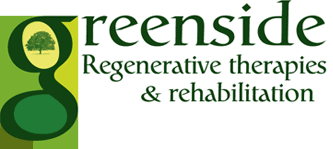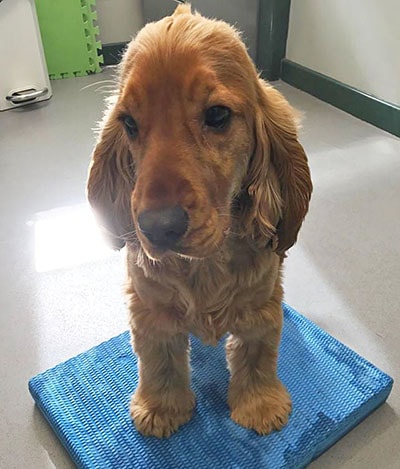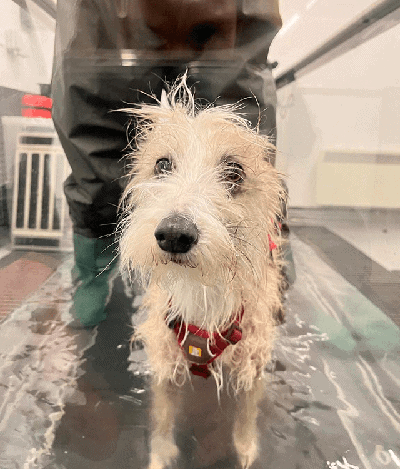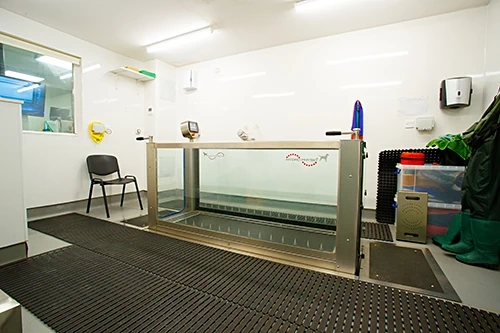Physiotherapy
Physiotherapy is defined as ‘the treatment of disease, injury, or deformity by physical methods such as massage, heat treatment and exercise rather than by drugs or surgery'.
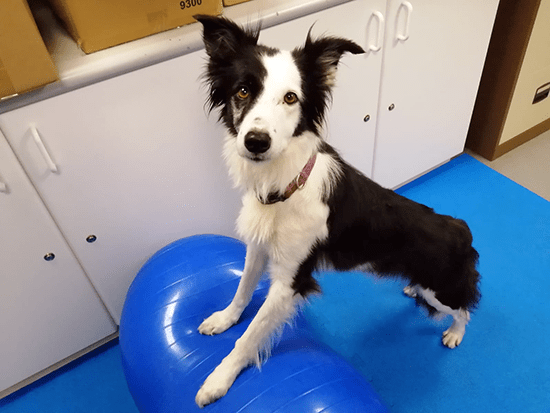 Historically very popular in humans, physiotherapy has been applied and developed more recently in the veterinary field. As a discipline, it works alongside veterinary intervention to further maximise results of treatment. Physiotherapy is often beneficial in instances where the animal is unable to have medication such as non-steroidal anti-inflammatories as well as when no further medication can be prescribed. Physiotherapy can aid in pain relief which makes it an ideal choice.
Historically very popular in humans, physiotherapy has been applied and developed more recently in the veterinary field. As a discipline, it works alongside veterinary intervention to further maximise results of treatment. Physiotherapy is often beneficial in instances where the animal is unable to have medication such as non-steroidal anti-inflammatories as well as when no further medication can be prescribed. Physiotherapy can aid in pain relief which makes it an ideal choice.
What does physiotherapy treat?
Physiotherapy can be used to treat many different conditions and the pain associated with them. Conditions that can benefit from physiotherapy include but are not limited to osteoarthritis, cruciate ligament disease, medial shoulder syndrome, hip/elbow dysplasia, lumbosacral disease, patellar luxation, and intervertebral disc disease (IVDD). Physiotherapy is also beneficial for animals' post-surgery, such as after spinal surgery or cruciate repair to aid early weight bearing and reduction of muscle loss.
How does physiotherapy work?
Physiotherapy utilises different techniques such as manual therapies, electro and Laser therapies, along with tailored home exercises.
Manual therapies
Massage is an umbrella term for many different techniques targeting pathologies. Stimulatory massage can be used to stimulate muscles after a period of disuse, using sharp and scattered strokes to trigger nerve firing and muscle activation. Effleurage massage can be used for relaxation and relief of tight muscles, using soft gentle strokes to encourage blood flow to the area. Friction massage can be used over a tendon or ligament injury to encourage correct alignment of fibres during repair.
LASER therapies
This therapy works on the principle of photo biomodulation to influence cellular respiration and energy production. Furthermore, the LASER light is warm, increasing blood flow and bringing more healing factors to the area. LASER is especially useful for pain relief, muscle tightness and relief of the symptoms of osteoarthritis, soft tissue injury, and wound healing.
Transcutaneous electromagnetic stimulation (TENS)
TENS is a common intervention in human therapy. It utilises the ‘pain gate’ theory to block transmission of pain messages to the brain. TENS provides almost instant pain relief to an area.
Neuromuscular electrical nerve stimulation (NMES)
NMES is a modality used for muscle mass increase. It manipulates the way muscles are activated in order to reduce muscle loss in areas of immobilisation as well as increasing muscle mass.
Pulsed electromagnetic energy (PEME)
PEME is a therapy used in areas of swelling, arthritis and nerve damage by the upregulation of growth factors, encouraging quicker new bone lay down and nerve firing.
Therapeutic Ultrasound (TUS)
This tool sends ultrasonic waves into the areas causing a vibration on the tissue which can help to increase the extensibility of soft tissues. Furthermore, TUS causes heat around the area and this increased blood flow can aid in reducing inflammation and pain. TUS is ideal for tendon and ligament pathologies.
Home exercise programmes
Your physiotherapist will prescribe you a programme of targeted exercises used to maximise the benefit of your pet’s rehabilitation. Cavaletti pole exercises can be used to train the animal’s gait and lengthen the stride after injury. Also, Cavaletti rails are often used for active range of motion, maintaining joint movement in a dog with joint issues. Wobble cushions are used as a core exercise. The unstable surface of the cushion requires balance and stabilisation using the animal’s abdominal muscles. Peanut ball exercises can be used to stretch the hip joint and associated musculature, as well as promoting shoulder and elbow muscle mass increase. Other exercises, such as sit-to-stands or cookie stretches can be prescribed for maintaining muscle, building up core strength, pain relief and stretching problem areas.
Physiotherapy and Regenerative Medicine
Physiotherapy is often used as a conjunctive therapy alongside regenerative medicine in order to maximise the benefits of stem cell therapy or platelet-rich-plasma. As well as being used for pain in relation to their condition, physiotherapy works to reduce the effects of immobilisation; minimising muscle loss throughout the body and aids in muscle strengthening in these areas.
Furthermore, it has been found that some electro and LASER therapies offered at Greenside, can help energise the stem cells after they have been implanted, reinforcing their use throughout the Stem Cell therapy process. It is commonly recommended for the animal to have six LASER sessions post implantation of stem cells.
Veterinary physiotherapists work under veterinary referral, meaning that a vet must refer the animal for physiotherapy. This can be achieved by completing one of our referral forms, which can be found and submitted online or sent to the veterinary practice directly. They must be completed and signed by the animal’s existing veterinary practice. Direct enquiries will also be responded to promptly.
What to expect?
Prior to the initial consultation your physiotherapist will evaluate your pet’s previous clinical history, including vet reports and any radiographs. During the initial physiotherapy consultation, the physiotherapist will conduct a full static assessment, feeling through all the muscles and joints, followed by a dynamic assessment of how the animal walks, looking at stride lengths and joint flexion. The physiotherapist will then talk through results with the owner and perform an appropriate first treatment. A bespoke home exercise programme will then be demonstrated and prescribed involving exercises to be completed at home to further benefit the animal.
Follow up sessions will also involve full static and dynamic assessments. The physiotherapist will perform another treatment on the animal and change the home exercise programme to suit the animal’s progress, whether it be adding more difficult exercises or reducing the workload. Electro or Laser therapies may be used in conjunction with manual therapies.
Many insurance companies will cover physiotherapy. Refer to your policy terms and conditions for more information.
Hydrotherapy
Hydrotherapy is an excellent option when you want a gentle but effective treatment that rebuilds your dog’s strength and flexibility.
In the treatment of humans and animals, hydrotherapy uses the physical properties of water to aid in the strengthening and re-education of the limbs.
The buoyancy of the water decreases the impact on weight-bearing areas of the body, which can reduce pain, allow greater range of movement and ease stiff joints all without the use of medication. The slow movement of limbs in water protects against further injury or strain. Combined, these are powerful elements of physical therapy that would not be otherwise possible for dogs that are constrained by debilitating conditions or injuries.
The process can also be used as a medium for the delivery of heat or cold to the body. The warmth of the water allows the muscles to relax which improves flexibility and circulation to the tissues and aides the healing process.
Hydrostatic forces of the water can also help to reduce inflammation of injured joints, therefore providing pain relief. The increased resistance caused by walking through the water in turn builds muscle strength and cardiovascular fitness.
What does hydrotherapy help to treat?
Hydrotherapy can help in the treatment of chronic conditions, post-operative recovery, weight loss and general fitness in dogs. Conditions that respond well to, or are managed by, hydrotherapy include osteoarthritis, cruciate or other ligament injuries or strains, muscle injuries, spinal conditions, obesity, and soft tissue injuries. It can also aid greatly in post-operative recovery from stem cell therapy.
What should I expect?
During the initial hydrotherapy consultation, the therapist will conduct a full static assessment, feeling through all of the muscles and joints, followed by a dynamic assessment of how the animal walks, looking at stride lengths and joint flexion. The therapist will then talk through results with the owner and perform an appropriate first treatment in the underwater treadmill depending on the pet’s abilities.
Follow up sessions will also involve full static and dynamic assessments as well as tailoring the underwater treadmill programme to challenge the pet.
Veterinary referral
Hydrotherapist’s work under veterinary referral, meaning that a vet must refer the animal for hydrotherapy. This can be achieved by completing one of our referral forms, which can be found and submitted online or sent to the veterinary practice directly. They must be completed and signed by the animal’s existing veterinary practice.
Like physiotherapy, many insurance companies will cover hydrotherapy. Refer to your policy terms and conditions for more information.
Post-Surgical rehabilitation
Underwater Treadmill
The underwater treadmill is a fantastic option for exercising your pet after surgery. The depth of the water can be changed to control the amount of weight that is being placed on the limbs while varying the speed of the treadmill to get your pet up and moving as quickly as possible for a better recovery.
Non-Surgical rehabilitation
Underwater Treadmill
For those instances when surgery is not an option, your veterinarian may determine that allowing a pet to walk in an underwater treadmill can still be extremely beneficial. Benefits include minimising how much muscle is lost due to inactivity, control a pet’s exercise while he or she is recovering from injury and help a pet’s mental well-being by allowing those with degenerative diseases the opportunity to walk with the support of the water.
Weight Loss
Underwater Treadmill
If your pet is overweight, the underwater treadmill can be a great way to help your pet comfortably shed those unwanted pounds. Your rehabilitation therapist will start your pet slowly and gradually increase his or her time and pace as the weight decreases and they get into better shape to improve their overall health.
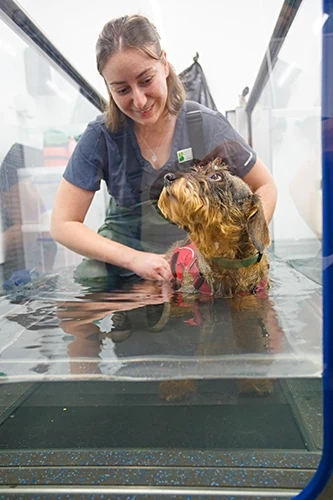 Conditioning
Conditioning
Underwater Treadmill
For those canine athletes that need an additional challenge, the underwater treadmill can really push your pet to his or her limits. Cardiovascular fitness, endurance, and muscle mass can all be increased when your pet exercises in water. And, for those times of the year when exercising outside is not ideal, this provides you with an option for keeping him or her in shape for the next competition.
Diagnosis
Underwater Treadmill
When pets walk in water, they tend to exaggerate how they step more than they do when they walk on land. This can allow us to observe if there is a problem with how they are walking and determine a course of action to treat the issue.
